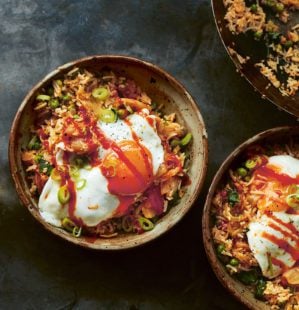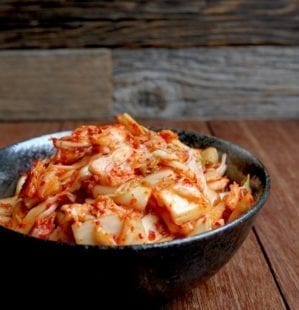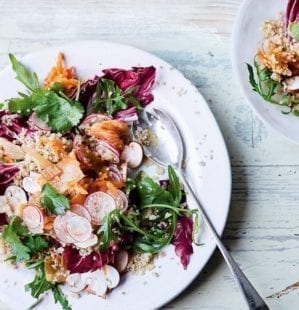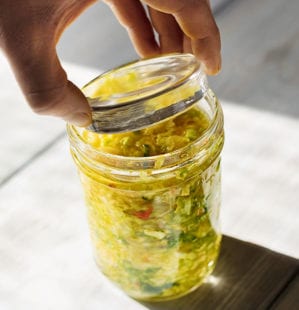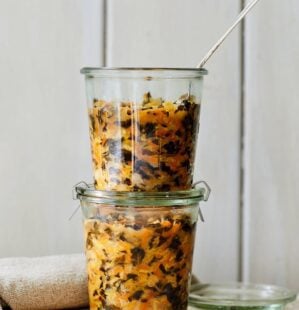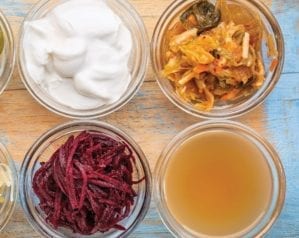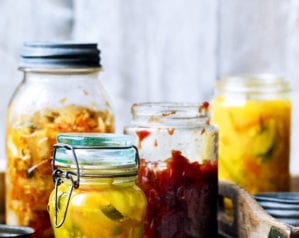
Vegan kimchi
- Published: 5 Jul 22
- Updated: 25 Mar 24
Make vegan kimchi with Ching He Huang’s step-by-step recipe. Swap traditional fish sauce for red miso to make this funky, fermented cabbage dish vegan friendly.
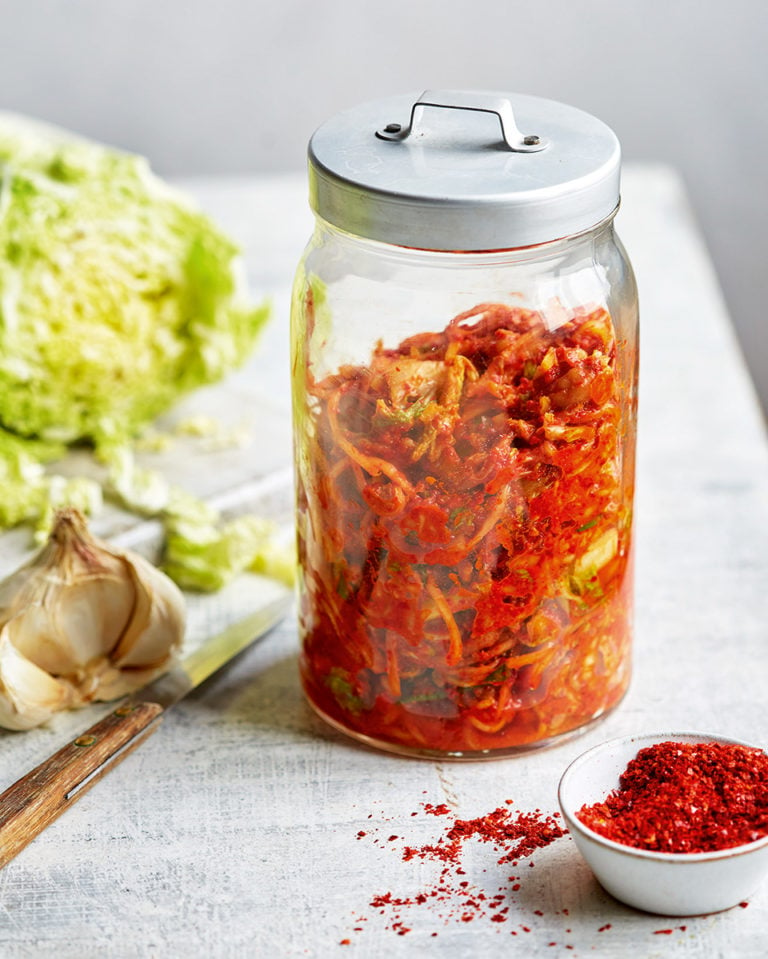
Love those punchy flavours? Try our carrot and cabbage kimchi, next.
Born in Taiwan and raised in South Africa and the UK, Ching has become a world ambassador for Chinese cooking and received an MBE in 2020 for services to the culinary arts. Her food ethos is all about using fresh, ethically sourced ingredients to create modern dishes with respect for heritage. Her latest book, Asian Green, was published in 2021 by Kyle Books.
-
Makes 1.5 litres (including the cabbage and juices)
-
Hands-on time 15 min, plus 6-8 hours soaking and at least 3 days fermenting
Ingredients
- 2 chinese cabbages
- 65g sea salt flakes
- 1 daikon/mooli, peeled and sliced into julienne strips (matchsticks) – see Know How
- 3 spring onions, trimmed and cut into 5cm slices
- 2.5cm piece fresh ginger, peeled
- 8 garlic cloves, peeled
- 2 shallots, peeled
- 6 tbsp gochugaru (Korean red pepper flakes), or more if you like it spicier – see Know How
- 2 tbsp red miso paste (from Waitrose and online suppliers – see Ching’s tip)
- 2 tsp caster sugar
- 1 tbsp glutinous rice powder (optional; also known as glutinous rice flour – see Know How)
- Sesame seeds, toasted in a dry pan, to serve (optional)
Method
- Reserve 1-2 outer leaves of the cabbages. Wrap them in damp kitchen paper and put in the fridge until needed. Shred the remaining cabbage and put in a large, deep pot or bowl. Add the salt and toss well. Add enough cool water to cover the cabbage and stir until the salt has dissolved. Put a plate on top to keep the cabbage submerged, then leave at room temperature for 6-8 hours or overnight (stir halfway through if possible).
- Drain the cabbage, reserving the brine. Rinse the cabbage, squeeze out any excess water, then return it to the bowl, adding the daikon/mooli and spring onions. Put the ginger, garlic, shallots, gochugaru, red miso paste and sugar in a food processor. Add the rice powder, if using. Pulse until the mixture forms a paste, then spoon the paste over the vegetables. Using tongs or gloves, mix and massage the vegetables and paste together until well coated. Pack the mixture into a sterilised 2 litre jar, leaving 3-5cm space at the top (see Ching’s tips for success). Add enough of the reserved brine to just cover the vegetables, pressing them down a bit. Place the whole cabbage leaf or leaves over the top, pressing down – this should help keep the kimchi submerged under the brine (or see Ching’s tips for success).
- Cover loosely (to allow air to escape) and put the jar in a baking dish or large bowl to collect any juices that escape (see Ching’s tips for success). Leave the jar in the kitchen, out of direct sunlight, for 3 days. During this time, you can press down on the kimchi daily with the back of a wooden spoon to keep it all submerged.
- After 3 days the kimchi will be ready, but it won’t achieve its full flavour and complexity for about another 2 weeks, so I suggest you seal the jar and transfer it to the fridge, where the kimchi will continue to slowly ferment (see Ching’s tips for success).
- To serve, scoop out using a slotted spoon, transfer to a side dish and dress with toasted sesame seeds. It’s delicious on top of noodle soups or stews – or added to a stir-fry. Enjoy!
- Recipe from July 2022 Issue
Nutrition
- Calories
- 46kcals
- Fat
- 0.4g (0.1g saturated)
- Protein
- 1.7g
- Carbohydrates
- 8.1g (3.7g sugars)
- Fibre
- 1.7g
- Salt
- 0.6g
delicious. tips
Ching’s tips for success:
Protect your hands The best way to mix and massage the kimchi (step 2) is
by using your hands, but do wear gloves to protect your skin from the chilli.Leave space in the jar Kimchi is ‘alive’ with bacteria and needs space to breathe, so it’s important to leave at least 3-5cm between the kimchi, liquid and the top of the jar and not to pack in the kimchi too tightly. You want to keep as much of the flavourful juice in the jar as possible, too, so resist the urge to overfill it. With fermentation, the bacteria produce gases that can build up pressure in the jar and even explode if there isn’t space or the lid is too tight.
A fermentation weight is useful To weigh down the kimchi, you can use
a fermentation weight if you have one, placing it on top of the whole cabbage
leaves to keep the kimchi submerged. This will help it stay packed yet loose, so it ferments fully.Ferment longer for flavour The longer you ferment your kimchi, the more complex the taste. It will keep in the fridge for several months, as long as it’s submerged in the brine. After you take some kimchi out of the jar, make sure the rest is submerged in the brine or it will turn mouldy.
Make it vegan Traditional kimchi uses fish sauce, but my vegan version uses red miso paste to achieve that umami taste. You could use yellow miso paste instead, but I find red miso gives a deeper flavour (check it’s gluten free if you need it to be).
Daikon/mooli is a large white radish. You can buy it from greengrocers, Ocado or redrickshaw.com. Gochugaru is a staple spice in Korean cooking. Deseeded chillies are dried, then coarsely ground into a powder that has smoky, fruity notes, plus a kick of heat. It’s worth getting hold of the proper stuff for kimchi. Buy it from Southeast Asian food shops or online from sous-chef.co.uk and theasiancookshop.co.uk
Buy ingredients online
Rate & review
Rate
Reviews
Subscribe to our magazine
Food stories, skills and tested recipes, straight to your door... Enjoy 5 issues for just £5 with our special introductory offer.
Subscribe
Unleash your inner chef
Looking for inspiration? Receive the latest recipes with our newsletter

